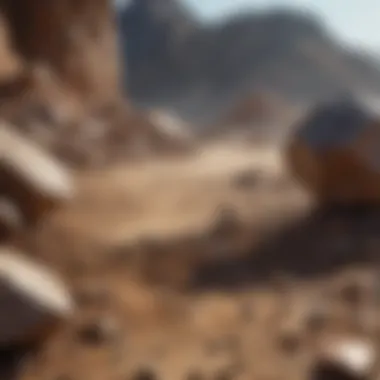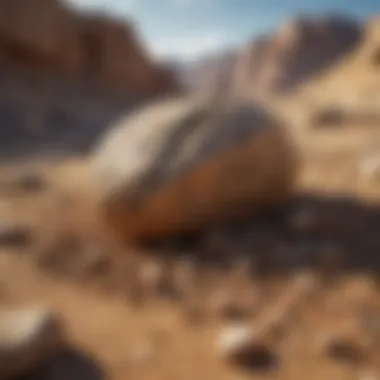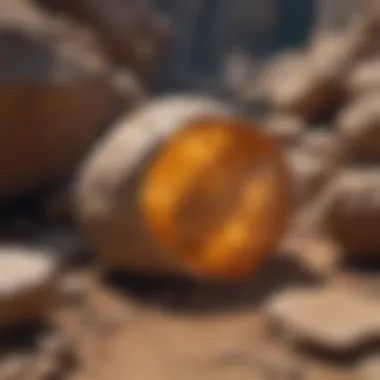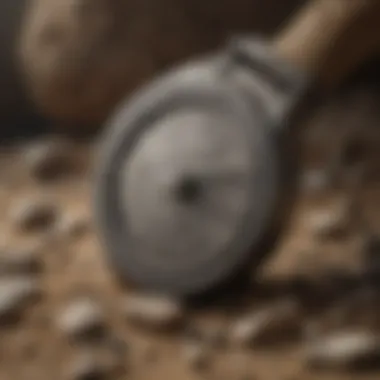Revolutionizing Geological Specimen Collection: The Cutting-Edge Tool for Rock-Dirt Separation


Rock and Fossil Identification
In the realm of rock and fossil identification, it is essential to discern various types of rocks and fossils based on distinctive characteristics. Rocks can range from sedimentary, igneous, to metamorphic types, each with unique features revealing their formation processes over millennia. Similarly, fossils offer glimpses into ancient life forms, from trilobites to dinosaur bones, requiring keen observational skills to identify. The tools utilized for identification tasks include magnifying glasses, chisels, and field guides rich in geological knowledge.
Collecting Tips and Techniques
When embarking on the journey of rock and fossil collection, adhering to best practices is fundamental. It's crucial to research and locate prime collecting sites known for abundant geological treasures. Safely extracting specimens from their resting places demands patience and precision to avoid damaging delicate structures. Techniques involving brushes, small tools, and protective gear aid collectors in carefully unearthing and handling valuable finds.
Preservation and Display
Preservation techniques play a vital role in maintaining the integrity of collected rocks and fossils. Employing methods such as stabilization with consolidants and storage in acid-free containers ensures long-term durability. Proper storage techniques, including temperature and humidity control, prevent degradation and corrosion over time. For display purposes, enthusiasts can explore creative ideas like shadow boxes, shelves, or museum-quality stands to showcase their prized specimens.
Geological Insights
Delving into geological insights provides a deeper understanding of the Earth's history and evolution. Studying various formations unveils the dynamic processes shaping landscapes, from sedimentation to tectonic movements. Rocks and fossils hold significant historical value, offering glimpses into past ecosystems and climate conditions. Notable discoveries in the field, such as the Burgess Shale or Laetoli footprints, provide invaluable insights into ancient life forms and evolutionary pathways.
Introduction
As we embark on the journey into the realm of rock and fossil collecting, the pivotal role of efficiency in separating rocks from dirt becomes abundantly clear. This article delves deep into the innovative tool that is set to revolutionize this process, offering rock and fossil collectors a game-changing solution. By dissecting the nuances of this tool, we unravel a world of possibilities for enhancing geological specimen collection and preservation.
Delving into the world of geological exploration, we find that traditional rock sorting methods often fall short in efficiency. The laborious and time-consuming nature of separating rocks from dirt has long been a challenge for collectors. However, with the advent of advanced separation techniques, there arises a demand for a more streamlined approach - cue the innovative tool we are about to uncover.


Introducing this cutting-edge tool marks a significant leap forward in the realm of rock and fossil collection. Its precision rock identification capabilities, coupled with an efficient dirt removal mechanism and a user-friendly operation interface, promise to reshape the way collectors interact with their specimens. Join us as we unravel how this innovative tool is poised to address key pain points in rock and fossil collection, setting a new standard for efficiency and precision.
Understanding the Need for Efficiency
In this article, we delve into the pivotal aspect of efficiency regarding the separation of rocks from dirt. Efficiency here is not merely about speed but also accuracy and resource optimization. By honing in on efficiency, we aim to streamline the process for rock and fossil collectors, enhancing their overall experience and results. Efficiency plays a crucial role in maximizing output while minimizing input, making it a cornerstone in any rock sorting operation.
Challenges in Traditional Rock Sorting Methods
Traditional methods of rock sorting have long been plagued by inefficiencies and inaccuracies. The manual sorting process is labor-intensive and time-consuming, often leading to subpar results. Moreover, the lack of precision in traditional methods hampers the ability to accurately differentiate between rocks and dirt. This inefficiency not only slows down the collection process but also increases the risk of overlooking valuable specimens.
Demand for Advanced Separation Techniques
The growing demand for advanced separation techniques stems from the need for improved accuracy and speed in rock sorting. As collectors strive to build comprehensive and high-quality collections, the limitations of traditional methods become increasingly apparent. Advanced separation techniques promise to revolutionize the field by offering a more precise and efficient way to separate rocks from dirt. By meeting the evolving needs of collectors, these techniques pave the way for enhanced collection practices and increased productivity.
Introducing the Innovative Tool
At the forefront of modern rock sorting technology stands the innovative tool designed to elevate sorting efficiency. This tool integrates cutting-edge features to optimize the separation process, catering to the specific requirements of rock and fossil collectors. By harnessing state-of-the-art mechanisms and advanced algorithms, this tool ensures swift and accurate rock identification while efficiently removing dirt. The introduction of this innovative tool marks a significant milestone in the quest for enhanced efficiency and precision in rock sorting operations.
Exploring the Key Features
One of the primary features highlighted is the precision rock identification mechanism. This advancement allows users to accurately distinguish between rocks and dirt, streamlining the sorting process with remarkable accuracy. By detailing the intricacies of this technology, collectors can optimize their specimen separation with confidence and efficiency.
Another key aspect to explore is the efficient dirt removal mechanism integrated into the tool. This mechanism plays a pivotal role in expediting the separation process, ensuring quick and effective removal of unwanted soil from valuable rocks. Understanding how this feature contributes to overall efficiency will help collectors appreciate the tool's impact on their workflow.


Moreover, the user-friendly operation of the tool is a standout feature worth discussing in detail. The intuitive design and easy-to-use interface make it accessible to collectors of varying skill levels. By elucidating on the simplicity and functionality of this aspect, readers can grasp how the tool enhances user experience and promotes seamless operation.
In essence, exploring the key features provides a comprehensive overview of the tool's innovative design and functionality, setting the stage for a deeper dive into its benefits and implications. By dissecting each feature, collectors can gain a nuanced understanding of how this tool elevates their rock and fossil sorting practices.
Precision Rock Identification
Precision rock identification is a critical component of the tool, enabling users to accurately differentiate between rocks and dirt. This feature utilizes state-of-the-art technology to analyze and categorize geological specimens with high precision. By leveraging this advanced identification system, collectors can significantly enhance the accuracy and efficiency of their sorting process, leading to improved specimen collection outcomes.
Efficient Dirt Removal Mechanism
The efficient dirt removal mechanism embedded in the tool is a game-changer for collectors seeking streamlined sorting processes. This mechanism employs advanced algorithms to swiftly and effectively remove dirt from rocks, optimizing the separation workflow. By understanding the mechanics behind this mechanism, collectors can appreciate the time-saving and precision-enhancing benefits it offers, revolutionizing their collection practices.
User-Friendly Operation
The user-friendly operation of the tool caters to collectors of all experience levels, providing a seamless and intuitive sorting experience. With clear instructions, customizable settings, and ergonomic design, this feature ensures that users can efficiently operate the tool without unnecessary complications. By prioritizing user-centric design, the tool promotes accessibility and ease of use, empowering collectors to enhance their specimen collection practices with confidence.
Benefits of Utilizing the Tool:
Time-Saving Efficiency:
This groundbreaking tool excels in its ability to expedite the rock-dirt separation process, saving collectors valuable time and streamlining their workflow. Traditional methods often involve labor-intensive and time-consuming sorting processes, which can be significantly reduced with the utilization of this tool. The advanced technology embedded in the tool enables swift and accurate identification of rocks, expediting the separation process without compromising precision. By automating previously manual tasks, collectors can achieve in minutes what would have traditionally taken hours. This increased efficiency not only enhances productivity but also opens up new possibilities for collectors to explore and expand their collections without being hindered by tedious sorting procedures.


Enhanced Collection Precision:
One of the standout features of this innovative tool is its unparalleled ability to enhance the precision of rock collection. By incorporating cutting-edge technology for rock identification, the tool ensures that only the intended specimens are retained during the separation process. This precision eliminates the need for manual verification or re-sorting, reducing the chances of errors and ensuring that collectors obtain exactly the rocks they desire. The accuracy of the tool contributes to a more refined and curated collection, elevating the overall quality of specimens acquired. Collectors can focus their efforts on specific rocks of interest, enhancing their expertise and enriching their collection with rare or unique specimens that align with their preferences.
Reduced Risk of Specimen Damage:
In the meticulous realm of rock and fossil collection, the risk of specimen damage during the separation process is a primary concern for collectors. However, with the implementation of this innovative separation tool, the risk of damaging specimens is significantly mitigated. The tool's gentle and efficient dirt removal mechanism ensures that rocks are separated from dirt with utmost care and delicacy. This preventive approach reduces the likelihood of chipping, scratching, or breakage that can often occur with manual separation methods. By safeguarding the integrity of specimens, collectors can preserve the beauty and authenticity of their rocks, contributing to a higher level of satisfaction and preservation of their geological collection.
Implications for Rock and Fossil Collectors
The section on 'Implications for Rock and Fossil Collectors' delves deep into the pivotal role this innovative tool plays in the realm of rock and fossil collection. By elevating traditional collection practices, this tool has transformed the way collectors approach their craft. Gone are the days of tediously sifting through dirt to uncover hidden gems; with this tool, the process is streamlined and highly efficient. Collectors are now able to identify and extract rocks with precision, enhancing the overall quality of their collections. This efficiency translates to significant time savings, allowing collectors to focus more on the thrill of discovery rather than menial tasks.
Elevating Collection Practices
The subsection on 'Elevating Collection Practices' elaborates on how this tool raises the bar for collectors worldwide. With its advanced rock identification capabilities, collectors can now pinpoint valuable specimens with unparalleled accuracy. This not only enriches their collections but also elevates their expertise in the field. The tool's user-friendly operation further enhances the collecting experience, making it accessible to novices and seasoned collectors alike. By simplifying the process of separating rocks from dirt, this tool promotes a more systematic and meticulous approach to collection, ensuring that every find is handled with care and precision.
Facilitating Preservation Efforts
In the section on 'Facilitating Preservation Efforts,' the focus shifts to the tool's role in safeguarding valuable specimens for future generations. By minimizing the risk of specimen damage during the separation process, this tool ensures that rocks and fossils remain intact and pristine. This is crucial for maintaining the integrity of collections and contributing to scientific research. Collectors can now preserve delicate specimens with ease, thanks to the tool's efficient dirt removal mechanism and gentle handling. As a result, the longevity and quality of collections are significantly enhanced, paving the way for continued exploration and study.
Promoting Sustainable Collection Methods
Lastly, the subsection on 'Promoting Sustainable Collection Methods' highlights the tool's contribution to environmentally conscious practices within the collecting community. By streamlining the separation process, this tool reduces unnecessary waste and ensures minimal disturbance to natural habitats. Collectors can now pursue their passion with a focus on sustainability, minimizing their impact on the environment while maximizing their discoveries. This shift towards more sustainable collection methods aligns with global efforts towards conservation and responsible resource management, positioning collectors as stewards of the Earth's geological heritage.
Conclusion
The Conclusion serves as a testament to the transformative power of embracing advanced separation techniques in the realm of rock and fossil collection. By encapsulating the discourse on time-saving efficiency, enhanced precision in collection, and minimized risk of specimen damage facilitated by this tool, the Conclusion cements the position of this innovation as a game-changer in the field. It serves as a compass guiding collectors towards a future where preservation efforts are seamlessly intertwined with sustainable collection practices.
To fully appreciate the gravity of the Conclusion, one must reflect on the nuanced nuances of rock and fossil collection. It underscores the essence of precision rock identification, efficient dirt removal mechanisms, and user-friendly operations as pillars supporting a new era of collecting practices. By championing the holistic approach to collection, preservation, and sustainability, the Conclusion stands as a cornerstone in the edifice of modern rock and fossil collection methodologies.







